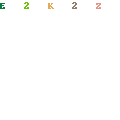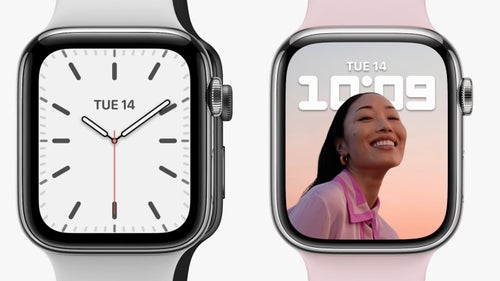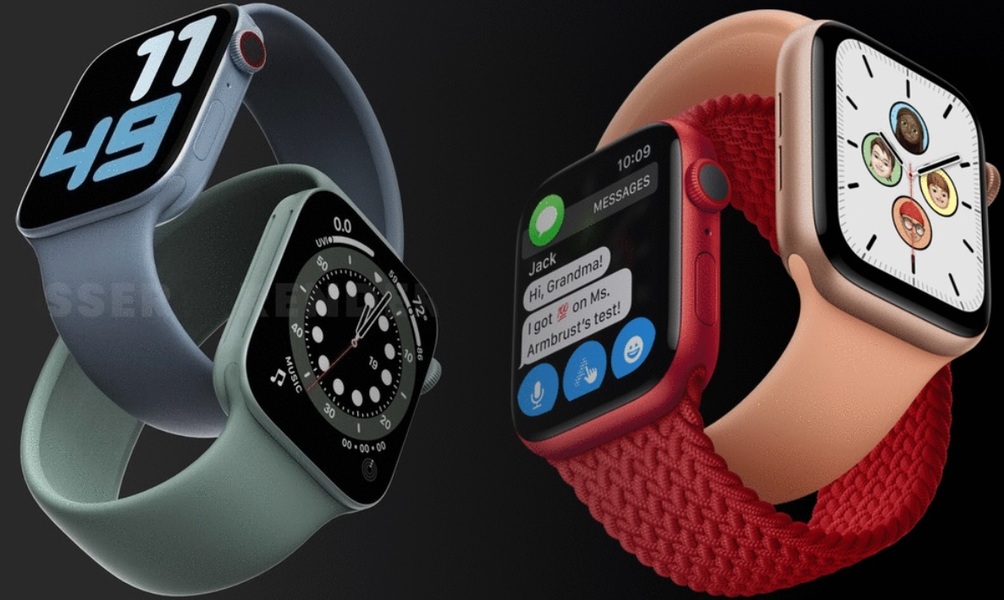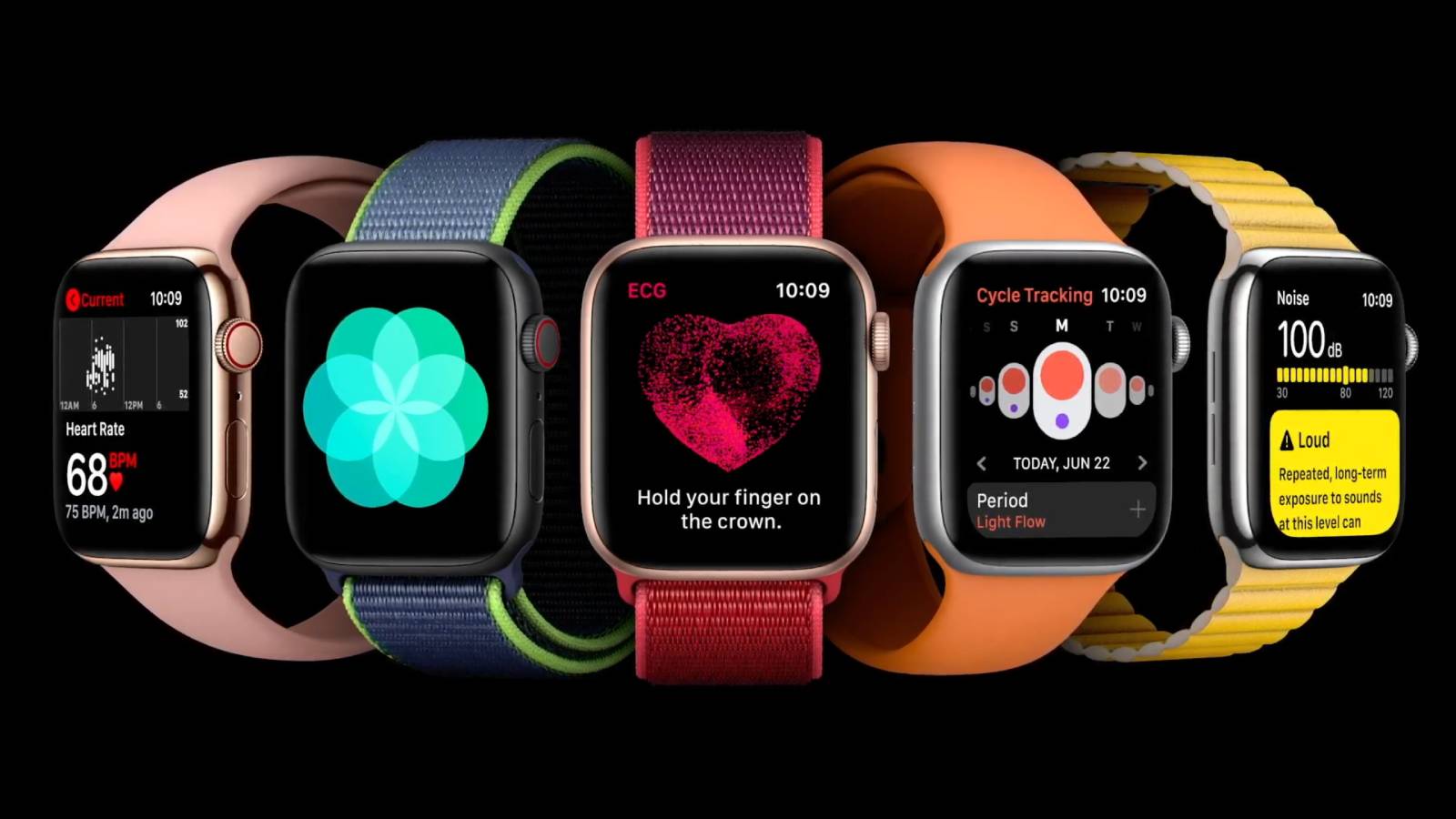The Apple Watch Series 7 offers the same suite of sensors as the Series 6. These include an accelerometer, a gyroscope, a heart rate sensor, a barometer, an always-on altimeter, a compass, an SpO2 sensor, and a VO2 max sensor. These sensors have a host of health and fitness tracking features, including blood oxygen monitoring, heart rate monitoring, sleep tracking, fall detection, workout tracking, and more. Additional features include a new S6 processor that is up to 20% faster than the S4 and S5, a 2.5× brighter always-on display, and an always-on altimeter. The S6 incorporates an updated, third generation optical heart rate sensor and also enhanced telecommunication technology, including support for ultra-wideband via Apple's U1 chip, and the ability to connect to 5 GHz Wi-Fi networks.
The Series 6 watch was updated with faster charging hardware such that it completes charging in ~1.5 hours. Force Touch hardware was removed, consistent with the removal of all Force Touch functionality from watchOS 7. The Apple Watch has been our longstanding Editors' Choice for its excellent performance, unparalleled app selection, and ample health and fitness tracking features. While it's no longer officially a part of Apple's wearable lineup, you can still buy the Apple Watch Series 6 at several retailers. The Apple Watch comes in two sizes, 40mm and 44mm, which start at $399 and $429, respectively.
The Series 6 features built-in sleep tracking, a great ecosystem of third-party complications, and more sensors than previous models, including one that allows the device to detect your body's blood oxygen levels. The new Apple Watch 6 features a number of improvements which includes a faster S6 chipset and next-gen always-on altimeter. One of the highlights of the device is its new heart rate sensor, which can be used to measure blood oxygen saturation . The new flagship wearable also comes with an advanced Retina display, accelerometer, gyroscope, and the latest motion sensors. The Apple Watch 6 also has a 2.5x brighter display as compared to its predecessor.
The ECG system has received clearance from the United States Food and Drug Administration, a first ever for a consumer device, and is supported by the American Heart Association. This device can also detect falls and will automatically contact emergency services unless the user cancels the outgoing call. The microphone was moved to the opposite side between the side button and the digital crown to improve call quality. Other changes include the digital crown incorporating haptic feedback with the Apple Haptic Engine and includes the new Apple-designed W3 wireless chip. The Apple Watch 6 offers blood oxygen monitoring, a brighter always-on display, an always-on altimeter and a faster chip. Rival smartwatch manufacturers seem to be taking larger leaps forward with their products, while Apple sticks to its incremental process (and it's 18-hour battery life).
The Apple Watch Series 7 offers the same health monitoring features available with the Series 6. A built-in accelerometer and gyroscope enable other important health-related features such as fall detection. We are hearing reports and rumors all around, but the most possible one could be sleep tracking as of now. However, it also means they will add suitable hardware to support it, and will also increase the prices. Moreover, we are also hearing some rumors about blood oxygen level tracking, although there is no solid evidence of what software and hardware can make it possible, so we are not holding our breath on it.
Also, we expect some design changes, as more screen and minimal bezels are also welcome. Additionally, fans will be eyeing for a better battery as we mentioned, but also faster charging. The next-gen iWatch is still way too far from release, so we will hear more details about it later as well. The Watch SE, which shares design elements with the Series 6, along with key health and safety features like fall detection, starts at $279 for the GPS-only model or $329 for the GPS and cellular version. It lacks an always-on display, as well as blood oxygen saturation and electrocardiogram readings—we go into detail on the differences between the two watches here.
It also works like an iPhone with numerous features like maps, app store, siri, apple music, text, make calls, sleep app and more. Get a healthy number of workouts, make a splash with your watch, check your heart rate, measure your blood oxygen levels, and generate ECG on your wrist. As for the sensors, the Watch Series 7 has the same sensor as that of the Apple Watch Series 6.
It includes an accelerometer, barometer, ECG , gyroscope, heart rate sensor, SpO2 sensor, and a VO2 Max sensor. Equipped with all these sensors, the Watch Series 7 offers blood oxygen monitoring, fall detection, heart rate monitoring, sleep tracking, and much more. That said, if the $399 starting price is out of your budget, the new Apple Watch SE offers many of the same features as the Series 6—including a handwashing timer, sleep tracking, heart rate notifications, and more—for $120 less. It lacks an always-on display and some of the Series 6's more advanced health features, however, including the ability to take an ECG and measure the oxygen saturation of your blood.
It's a strong alternative to the Series 6 if you don't mind a less health-focused experience. The Apple Watch Series 6 is powered by the new S6 SiP and offers new hardware and software features. You get a brand new SpO2 sensor for blood oxygenation levels and VO2 MAx readings from workouts.
Thanks to the new SiP we also get fast-charging of the Apple Watch for the first time, topping the battery from 5 percent to full in about 90 minutes. The Apple Watch is one accurate device when it comes to tracking different forms of workouts, recording the duration, effort and heart-rate related metrics with great accuracy. As far as the Apple Watch's smart capabilities are concerned, the app ecosystem for the Watch has come a really long way, allowing the watch to be a seamless extension of your iPhone. Force touch technology has been removed in Watch Series 6 and Watch SE. The watch also has a side button which can be used to display recently used apps and access Apple Pay, which is used for contactless payment.
If the watch's battery depletes to less than 10 percent, the user is alerted and offered to enable a "power reserve" mode, which allows the user to continue to read the time for an additional 72 hours, while other features are disabled. The watch then reverts to its original mode when recharged or after holding down the side button. Aside from shiny new colours, the headline feature is the ability to monitor your blood oxygen level. The smartwatch will keep tabs on your blood oxygen levels in the background and store the recorded data in the Health app on your iPhone. Blood oxygen levels are a good measure of your general fitness levels – as it shows how well your respiratory and heart health. However, Apple warns that "Blood Oxygen app measurements are not intended for medical use, including self-diagnosis or consultation with a doctor, and are only designed for general fitness and wellness purposes."
Apple hasn't explicitly mentioned the battery capacity of the Watch Series 7, but it should last an entire day on a single charge. However, compared the previous generation smartwatch model, the Watch Series 7 charges 33% faster. Apple has updated the charging architecture and used a Magnetic Fast Charger with a USB-C cable for the Watch Series 7.
If you charge the Watch Series 7 for up to 8 minutes, you can easily get 8 hours of sleep tracking. On the other hand, if price is your main concern and you do not need advanced health functions, the Apple Watch Series 3 may be more appropriate than the $399 Apple Watch Series 7 as it offers many of the Apple Watch's core features for just $199. There are some tradeoffs with the Apple Watch Series 3 because it is a much older model, such as a smaller display, an older chipset, and the lack of a compass, fall detection, ECG, and blood oxygen monitoring.
The Series 7 will use WatchOS 8 which comes with a whole set of health and fitness tracking features, metrics, and watch faces. Among the new changes is the Breathe app, letting you center and breathe more calmly, Reflect, to help you destress with soothing animations, and sleep tracking which can now measure respiratory rate and find trend changes. Meanwhile, the Workouts app lets you find new workout modes like Tai Chi and pilates. The Fitness+ app boasts seven new high-intensity workout plans, and there are motivational playlists to accompany the Artist Spotlight series. The Apple Watch Series 7 features a 20 per cent larger display that the Apple Watch Series 6 along with a new wraparound curved screen at the edges. The watch can now accommodate more text and graphical elements on the screen than before.
The watch promises 18 hours of battery life and faster charging speeds to older Apple Watch models as well as a new USB-C powered charger. At Rs 29,900, the Watch SE not only is only cheaper but has the same bigger display and latest features like fall detection, always-on altimeter. With the Series 3 now being three years old, we think the Watch SE is a better buy. Initial reviews for the device have been generally positive with some caveats.
Reviewers praised the watch's potential ability to integrate into everyday life and the overall design of the product, but noted issues of speed and price. Many reviewers described the watch as functional and convenient, while also noting failure to offer as much potential functionality as preceding smartphones. Farhad Manjoo of The New York Times mentioned the device's steep learning curve, stating it took him "three long, often confusing and frustrating days" to become accustomed to watchOS 1, but loved it thereafter. Some reviewers also compared it to competing products, such as Android Wear devices, and claimed "The Smartwatch Finally Makes Sense". He concluded that there is no "killer application" so far besides telling the time, which is the basic function of a wristwatch anyhow.
Each model through Series 3 comes in a 38- or 42-millimeter body, with the larger size having a slightly larger screen and battery. Featured Apple-made bands include colored sport bands, sport loop, woven nylon band, classic buckle, modern buckle, leather loop, Milanese loop, and a link bracelet. The Series 7 is also equipped with new hardware that enables ultra-rapid, short-range wireless data transfer at 60.5 GHz, though Apple has not fully explained this new functionality. TechRadar gave it a score of 4.5/5, calling it one of the top smartwatches, while criticizing the short battery life. Digital Trends gave it a score of 5/5, calling it Apple's best product and praising the design, build quality, and software, among others, while criticizing the battery life. CNET gave it a score of 8.2/10, calling it the "best overall smartwatch around", while criticizing the battery life and lack of watch face options.
T3 gave it a score of 5/5, calling it a "truly next-gen smartwatch" due to its thinner body and bigger screen compared to the Series 3, and health features. As an ultra low-cost option, Apple is continuing to sell the Apple Watch Series 3, priced starting at $199. The Series 3 has an older design with a smaller display, a much slower S3 chip, and no blood oxygen sensor or ECG function.
It is GPS only and lacks a few other bells and whistles like always-on altimeter and compass that are found in the other Apple Watch models. The Series 3 is several years old at this point and is using outdated technology, so we do not recommend purchasing it. Apple Watch Series 4, which launched a year later, featured a major redesign with a screen that was 30% bigger in both models and a 50% improvement on its processor over the Series 3 version. Speakers and microphones were rearranged so they were louder and more useful, and Series 4 introduced the fall detection feature, ECG capabilities, and the second-generation heart rate monitor. The Series 7 is powered by Apple's S7 SiP with 64-bit dual-core processor just like the S6, so no huge change there.
It also has the same sensor array on the back, ready to measure heart rate and blood oxygen and take an electrocardiogram reading. There's a new fall-detection feature that works during workouts and when cycling, and through WatchOS 8, the Series 7 will measure respiratory rate during sleep. It easily outperforms Google Wear OS-based watches like the Moto 360, and offers a much more fully realized smartwatch experience than Fitbit's more health-centric models. If you already own a Series 5, the Series 6 is really only worth the upgrade if you absolutely must have the always-on altimeter or SpO2 readings. But between its advanced health and fitness monitoring capabilities, safety and lifestyle features, and wide selection of downloadable apps, the Apple Watch Series 6 is the best smartwatch on the market hands down, and our Editors' Choice.
Since the Apple Watch made its debut five years ago, one of its primary functions has been to help you monitor your health. The Series 6 further impresses thanks to a faster processor, a brighter always-on display, and an improved altimeter that can track your elevation changes in real time. The Series 6 uses similar technology as a pulse oximeter—the device they clip onto your finger at the doctor's office—to measure your blood oxygen saturation.
Its SpO2 sensor shines red and infrared light through your skin, onto the blood vessels of your wrist, and measures the color of your blood, which indicates the amount of oxygen present. The Fitbit Sense and Fitbit Versa 3 are strong competitors if general health and fitness are what you're interested in. The Sense in particular is designed around matching heart rate and pulse oxygen with strong sleep tracking features and stress levels, to help you understand how different parts of your life affect each other. It's cheaper than the Series 6 too, but isn't as nicely made, and doesn't work as slickly with your iPhone. The Apple Watch Series 7, announced in September 2021, is the current iteration of the Apple Watch that originally launched in 2015 and replaced the Series 6.
The Apple Watch Series 7 builds on the design of previous Apple Watch models with a more rounded design and offers some notable new features including larger displays, improved durability, and faster charging. This Watch brought a new S6 processor, up to 20% faster than its predecessor, a brighter Always-On display, a blood oxygen app, and an always-on altimeter, alongside new health sensors. As in the case of Watch SE, the smartwatch has many features as the high-end Series 6 but cuts a few corners to keep the price down. For instance, the Watch SE features fall detection, noise monitoring, international emergency calling as well as the second-generation heart rate sensor. What's missing from the Apple Watch SE is the lack of the ECG sensor built into the Digital Crown.
No, the Apple Watch Series 7 has the same "all day" battery life as the previous model. The amount of usage you'll get out of it per charge depends on what you use the smartwatch for. Using the Apple Watch's fitness tracking features will tax its battery more intensely than occasionally checking the time and your notifications.
Apple is late to the game with sleep tracking capabilities, as most smartwatches and fitness trackers already offer this feature, and Apple's version is still pretty basic. After you wear the Apple Watch to bed, the Health app on your iPhone shows when you fell asleep, woke up, and your total time in bed and asleep for the night. It also shows a graph of your heart rate, with your maximum and minimum recorded beats per minute. It charts your sleep for the week and month, and shows your average time in bed and average time asleep.
This might sound negligible over previous years, but again, switching from the Series 3, there is definitely a noticeable weight difference to the new watch. Couple that with the larger size means the new form factor has taken a little bit of adjustment, and if a lightweight, low-profile watch is important to you for exercising, this is just something to bear in mind. On the whole, however, what Apple has done in packing this larger, more vibrant display, better battery life, and SiP improvements into a Watch that barely any bigger than the previous model is definitely to be lauded. A series of seemingly negligible design changes actually add up to make a big difference, and whilst at first glance the Series 7 doesn't look much different, it feels almost like a whole new product. Paradoxically, one of the best things about the Series 7 is that despite all the new screen real estate, it feels like the design, relatively speaking, has barely changed at all.
It does not have a built-in GPS chip, instead relying on a paired iPhone for location services. It uses a linear actuator called the "Taptic Engine" to provide haptic feedback when an alert or a notification is received, and is used for other purposes by certain apps. The watch is equipped with a built-in heart rate sensor, which uses both infrared and visible-light LEDs and photodiodes. All versions of the first-generation Apple Watch have 8 GB of storage; the operating system allows the user to store up to 2 GB of music and 75 MB of photos. When the Apple Watch is paired with an iPhone, all music on that iPhone is also available to be controlled and accessed from the Apple Watch. In comparison to other Apple products and competing smartwatches, marketing of the Apple Watch promoted the device as a fashion accessory.
Apple later focused on its health and fitness-oriented features, in an effort to compete with dedicated activity trackers. The watchOS 3 added fitness tracking for wheelchair users, social sharing in the Activity app, and a Breathe app to facilitate mindfulness. Apple has announced its sixth generation Apple Watch smartwatch, the first to track blood oxygen levels as the company continues its push into health and fitness. If you own an iPhone, the only smartwatches you should be looking at are the various Apple Watch models. Even though you can use smartwatches from many other brands with an iPhone, none of them offer the same level of integration, in my opinion.
Like clockwork, we got the Apple Watch Series 6 this year, and it features a new S6 SiP (System-in-Package) and a blood oxygen sensor, plus other small refinements. This year's refresh is yet another iterative one over the Apple Watch Series 5, which has been discontinued. We discuss the Apple Watch SE in a separate article, here we will be discussing the new features coming to Apple Watch Series 6, which include a new blood oxygen sensor and new blue and red colour options. Using red and infrared light, the new health sensor on the Apple Watch Series 6 is able to measure the user's blood oxygen levels in just 15 seconds.
This new sensor can also capture periodic background readings and store them in the Sleep app. The blood oxygen measuring feature is said to be especially useful for detecting respiratory and cardiac health issues. All Apple Watch Series 7 models feature a black ceramic and crystal back that houses four LED clusters and four photodiodes to facilitate health-monitoring features such as heart rate monitoring, blood oxygen monitoring, and ECGs.































No comments:
Post a Comment
Note: Only a member of this blog may post a comment.